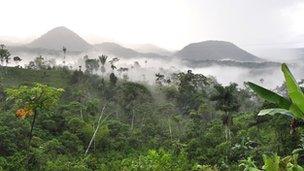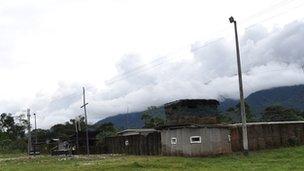Gold overtakes drugs as source of Colombia rebel funds
- Published

Rebels are now involved in legal and illegal gold mining
A decade ago, the Colombian region of Putumayo was the main production centre for coca, the raw material for cocaine.
And the guerrillas from the Revolutionary Armed Forces of Colombia (Farc) were well placed to profit from the illegal drugs trade.
Today, there are still small fields of bright green coca cut from the virgin jungle, but the rebels have found a more lucrative, and far safer, source of income: gold.
It was here the US military aid package, known as Plan Colombia, which has amounted to some $8bn (£5bn) since 1999, was concentrated.
Since 2000, fleets of spray planes have dropped glyphosate chemicals over the coca bushes, managing to reduce, but never eradicate, drug production.
What the chemicals have done is push local farmers into the new, informal industry of gold mining.
"We estimate that the Farc here make 800m pesos ($450,000) a week from illegal gold mining," said Jhimmy Calvache, the acting mayor of Mocoa in Putumayo province.

Without massive army support, police cannot check up on the Farc's activities
Colombia has vast gold deposits, especially along the rivers that wash down from the Andes Mountains.
It was gold that drew the Spanish conquistadors here in the 16th Century, and now, with prices high for precious metal, gold fever has returned.
Mechanical diggers operate along the riverbeds and banks in Putumayo, protected by heavily armed rebels who allow no access to the sites and impose huge "taxes" on production.
In March, police sought to send in investigators to find out how much gold was being extracted.
They ran into trigger-happy guerrillas and it was decided that, without massive army support, there was no chance of making any meaningful inquiries. The operation was abandoned.
Mine operators
While the illegal exploitation of gold in Putumayo is still in its infancy, it is well developed in other parts of the country.
In the northern department of Antioquia, the Farc have established a series of extortion schemes on the gold miners, legal and illegal.
For every mechanical digger that enters their territory, the rebels charge an initial "tax" of up to $3,000 and another $2,000 per piece of heavy machinery for every month of operation.
In the gold-rich municipality of Anori in Antioquia, authorities believe there are up to 120 diggers operating, earning the local Farc unit a monthly income of at least $240,000. There are 125 municipalities in Antioquia.
"Gold is now more lucrative than coca," says Antioquia Governor Sergio Fajardo.
The guerrillas are not just extorting money but running some mining operations themselves or demanding a percentage of all production.
The advantage of gold is that it is perfectly legal to transport and sell, unlike cocaine.
Indeed, legally registered mines have become a favourite acquisition for drug traffickers as well, as they are perfect vehicles for laundering money.
The mining companies can claim any amount of gold is being extracted and then traffickers put all their money from cocaine sales through the books.
On condition of anonymity, a mine worker in Anori played the recording on his telephone of a call he said was from the Farc demanding payment.
"Don't try my patience this month," growled a low voice, "don't make me look for you, or the machines will be burnt and you may become a military objective [this is guerrilla speak for becoming a target for assassination]."
He paid, and continues paying, even during the rainy season when the rising water levels make extracting gold from the river bed almost impossible.
Recruitment drive
In Putumayo, there is clear evidence that the rebels are strengthening themselves thanks to the cash from gold.
In the remote municipality of Puerto Guzman, 400 people were called in April by the rebels to attend a political meeting, where they said they were forced to listen to Marxist doctrine.
These meetings are increasingly common.
In Piamonte, accessible only by canoe, the rebels run football tournaments for the young people, to hook them in and prepare them for recruitment.

The police station in Piamonte, a series of bunkers connected by trenches, operates as if under siege
"We had a rebel incursion last month," said Piamonte local councillor Carlos Martinez, who moved his children away for fear of Farc recruitment.
"The guerrillas came into the town, to within 30 metres of the police station. The policemen did nothing, they never left their base."
The police station is a series of bunkers connected by trenches. Resupply is done by US-supplied Blackhawk helicopters.
Their landing is covered by a helicopter gunship hovering over the town, the gunner's finger never leaving the trigger of his machine gun that is capable of firing 800 rounds a minute.
A young policeman offered a few words from the barrier to the base, refusing to come out or let me in.
"We don't get much co-operation from the local community here. We never leave the town," he said, glancing nervously at the high ground within sniper range.
Putumayo used to produce up to 100 tonnes of cocaine a year. Now it produces around 40 tonnes.
But the shortfall in Farc revenue has been more than made up with illegal mining of gold.
As Colombia's conflict enters its 49th year, the 9,000-strong rebels are looking to gold to fund new offensives against the state.
- Published6 June 2012
- Published5 June 2012
- Published14 March 2012
- Published14 March 2012
- Published22 November 2011